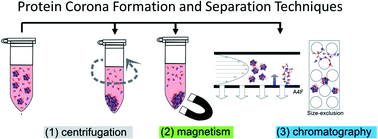当前位置:
X-MOL 学术
›
Nanoscale Adv.
›
论文详情
Our official English website, www.x-mol.net, welcomes your feedback! (Note: you will need to create a separate account there.)
Isolation methods for particle protein corona complexes from protein-rich matrices
Nanoscale Advances ( IF 4.7 ) Pub Date : 2020/01/09 , DOI: 10.1039/c9na00537d Linda Böhmert 1 , Linn Voß 1 , Valerie Stock 1 , Albert Braeuning 1 , Alfonso Lampen 1 , Holger Sieg 1
Nanoscale Advances ( IF 4.7 ) Pub Date : 2020/01/09 , DOI: 10.1039/c9na00537d Linda Böhmert 1 , Linn Voß 1 , Valerie Stock 1 , Albert Braeuning 1 , Alfonso Lampen 1 , Holger Sieg 1
Affiliation

|
Background: Nanoparticles become rapidly encased by a protein layer when they are in contact with biological fluids. This protein shell is called a corona. The composition of the corona has a strong influence on the surface properties of the nanoparticles. It can affect their cellular interactions, uptake and signaling properties. For this reason, protein coronae are investigated frequently as an important part of particle characterization. Main body of the abstract: The protein corona can be analyzed by different methods, which have their individual advantages and challenges. The separation techniques to isolate corona-bound particles from the surrounding matrices include centrifugation, magnetism and chromatographic methods. Different organic matrices, such as blood, blood serum, plasma or different complex protein mixtures, are used and the approaches vary in parameters such as time, concentration and temperature. Depending on the investigated particle type, the choice of separation method can be crucial for the subsequent results. In addition, it is important to include suitable controls to avoid misinterpretation and false-positive or false-negative results, thus allowing the achievement of a valuable protein corona analysis result. Conclusion: Protein corona studies are an important part of particle characterization in biological matrices. This review gives a comparative overview about separation techniques, experimental parameters and challenges which occur during the investigation of the protein coronae of different particle types.
中文翻译:

从富含蛋白质的基质中分离颗粒蛋白质电晕复合物的方法
背景:当纳米粒子与生物体液接触时,它们会迅速被蛋白质层包裹。这种蛋白质外壳称为电晕。电晕的组成对纳米粒子的表面性质有很大的影响。它可以影响它们的细胞相互作用、摄取和信号传导特性。出于这个原因,蛋白质电晕作为颗粒表征的重要组成部分经常被研究。摘要主体:蛋白质电晕可以通过不同的方法进行分析,这些方法具有各自的优势和挑战。从周围基质中分离电晕结合颗粒的分离技术包括离心法、磁力法和色谱法。使用不同的有机基质,例如血液、血清、血浆或不同的复杂蛋白质混合物,并且方法在时间、浓度和温度等参数上有所不同。根据所研究的粒子类型,分离方法的选择对后续结果至关重要。此外,重要的是包括合适的对照以避免误解和假阳性或假阴性结果,从而获得有价值的蛋白质电晕分析结果。结论:蛋白质电晕研究是生物基质中颗粒表征的重要组成部分。本综述对分离技术、实验参数和在研究不同粒子类型的蛋白冠期间出现的挑战进行了比较概述。
更新日期:2020-02-19
中文翻译:

从富含蛋白质的基质中分离颗粒蛋白质电晕复合物的方法
背景:当纳米粒子与生物体液接触时,它们会迅速被蛋白质层包裹。这种蛋白质外壳称为电晕。电晕的组成对纳米粒子的表面性质有很大的影响。它可以影响它们的细胞相互作用、摄取和信号传导特性。出于这个原因,蛋白质电晕作为颗粒表征的重要组成部分经常被研究。摘要主体:蛋白质电晕可以通过不同的方法进行分析,这些方法具有各自的优势和挑战。从周围基质中分离电晕结合颗粒的分离技术包括离心法、磁力法和色谱法。使用不同的有机基质,例如血液、血清、血浆或不同的复杂蛋白质混合物,并且方法在时间、浓度和温度等参数上有所不同。根据所研究的粒子类型,分离方法的选择对后续结果至关重要。此外,重要的是包括合适的对照以避免误解和假阳性或假阴性结果,从而获得有价值的蛋白质电晕分析结果。结论:蛋白质电晕研究是生物基质中颗粒表征的重要组成部分。本综述对分离技术、实验参数和在研究不同粒子类型的蛋白冠期间出现的挑战进行了比较概述。



























 京公网安备 11010802027423号
京公网安备 11010802027423号